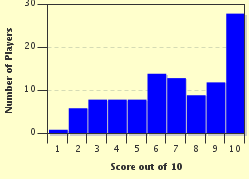Quiz Answer Key and Fun Facts
1. No cars go to Ostrov Uyedineniya (also known as "Lonely Island") because no one has lived there since November 1996. That is when the weather station on this ice-encrusted island, where the average annual temperature is -16 degrees C, closed. In what ocean can you find this Russian island?
2. No cars go on the British-administered island of Tristan da Cunha. That's because this Atlantic Ocean island of 260 people lies 1,750 miles from the Cape of Good Hope--the nearest populated land. What sobriquet does Tristan da Cunha hold?
3. No cars go on Amsterdam Island (Ile Amsterdam in French) because the only habitation there is a French weather, ornithology, geomagnetism and physical chemistry base. Amsterdam Island is located in the southern part of the Indian Ocean, approximately halfway between Australia and South Africa. It is one of only three land antipodes to what country? (A land antipode is a land segment that is directly opposite another land segment on the Earth's surface.)
4. No cars go on this coral island located about 1,700 miles from Honolulu. That's because the island is uninhabited. There was at one time a three-runway airport there, built in anticipation of Amelia Earhart's arrival for fuel on her round-the-world flight. This is also the last place radio contact with Earhart was heard. What island is this?
5. No cars go this Pacific island located 450 miles from New Zealand. The island was discovered in 1800 by a Captain Henry Waterhouse who calculated that the island was exactly opposite his homeland of England in general and London specifically. Knowing that, what do you think he named the island?
6. Perhaps some cars go on Floreana Island. That is because the island has one city and that city has a population of 100. Floreana is one of a group of volcanic islands belonging to Ecuador and situated near the equator in the Pacific Ocean. Other islands in the group include San Cristobal, Bartholomew, South Seymour and Espanola. What is the name of this group of islands?
7. Few cars go on the island that housed the HMS Bounty mutineers. That is because only some four dozen people live there and the only road is four miles long from the bay to Adamstown. What Pacific island is this?
8. No cars go on Semisopochnoi Island in the Bering Sea. That's because no one has ever lived there. Semisopochnoi is a volcanic island with an interesting feature. It has a volcano with three peaks. The volcano is named after a figure from Greek mythology. What is the volcano's name?
9. No cars go on Raoul Island. There is a tractor, though. That's because Raoul is a nature reserve. The only people there are biologists from the New Zealand Department of Conservation and their volunteer assistants. Raoul is located in the Kermadec Islands, about 680 miles northeast of New Zealand. In what ocean does Raoul Island lie?
10. No cars go on the atoll of Takuu. That's because the only residents are native tribespeople. In fact, no one else is allowed to land there. Takuu is part of a Pacific chain that includes Bougainville, New Britain and New Ireland. To what independent state does Takuu belong?
Source: Author
deputygary
This quiz was reviewed by FunTrivia editor
ozzz2002 before going online.
Any errors found in FunTrivia content are routinely corrected through our feedback system.


